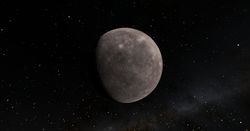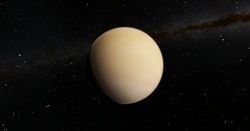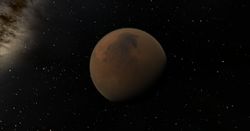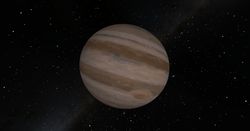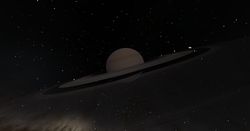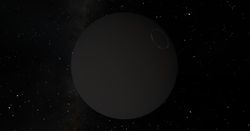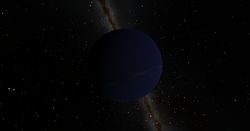Difference between revisions of "Sol"
Tablespoon (talk | contribs) |
Tablespoon (talk | contribs) m (Reverted edits by Tablespoon (talk) to last revision by RustySh4ckleford) |
||
| Line 1: | Line 1: | ||
Sol is a stable G-class main-sequence yellow dwarf star classified in the spectral class of G2. It more than 4.5 billion years old, and has eight planets in orbit around it, as well as an asteroid belt, a rocky dwarf planet and a cloud of icy comets. One of the planets in orbit around Sol is Earth, where Humans first evolved. Most standardized systems of cosmic measurement and timekeeping are based upon Sol and its planet Earth. Earth and three other planets in orbit around Sol are rocky and rich in resources, and the remaining four planets are gas giants. | |||
==Planets and Major Bodies in Orbit== | |||
==Planets and Major Bodies== | |||
===Mercury (Sol I)=== | ===Mercury (Sol I)=== | ||
| Line 26: | Line 7: | ||
===Venus (Sol II)=== | ===Venus (Sol II)=== | ||
[[Image:Venus.jpg|thumb|250px|The | [[Image:Venus.jpg|thumb|250px|The superdense atmosphere of the planet Venus has caused a runaway greenhouse effect.]]Venus is the second terrestrial planet in the Sol system. It orbits Sol at an average distance of 0.72 AU. A Venusian year lasts 225 standard days, while a Venusian day is longer, at 243 standard days. Venus spins retrograde when compared to the other planets in the Sol system, causing the sun to rise in the west and set in the east in its sky. Venus has an extremely thick and toxic atmosphere, composed of large amounts of carbon dioxide and nitrogen. The rain that falls upon the surface is composed of sulfuric acid. Because of how thick the planet’s atmosphere is, a runaway greenhouse effect has made the planet uninhabitable to all life. The atmosphere is so thick that it exerts massive amounts of pressure on the surface, which has crushed all but the most structurally reinforced of scientific equipment sent to study the planet, while the rest was destroyed by caustic acid rain. The planet hosts massive amounts of volcanic activity, which spew more toxic gases into the atmosphere. Almost no sunlight reaches the surface of the planet, yet temperatures exceed 480 °C. No attempt has ever been made to colonize the planet due to extreme conditions. Civilian travel is not advised. | ||
===Earth (Sol III)=== | |||
[[Image:Earth(2456).jpg|thumb|250px|Earth is the homeworld of humanity and was once home to millions of species. It has since suffered ecological devastation.]]Earth is the third planet out from Sol, and the original homeworld of the species Homo sapiens, or as they’re collectively known, Humanity. Despite being considered irrelevant in human politics in the current age, almost all standardized units of measure were either based on aspects of Earth, or were developed on it. For example, standard years are actually Earth years, and standard days and hours are Earth days and hours. Despite the splintering of humanity along the lines of different political systems, interstellar geography and warring sects, standard units of measure are omnipresent, with the few exceptions being colonies far removed from the core worlds attempting to distance themselves from the past. Earth was originally a Garden world, harboring millions of unique species of flora and fauna. It was extremely diverse in ecosystems, with huge deserts, sprawling tundra, massive mountain ranges, rolling grasslands, and thick swaths of tropical rain forest. 71% of the Earth’s surface was covered in salt water, although there existed massive lakes of fresh water within continental areas. It was a temperate world before it was polluted and then annihilated with thermonuclear fire. In the modern age, Earth is mostly uninhabitable, with only a few areas having been terraformed and shielded from the rest of the irradiated geosphere. Earth is also the cradle world of humanity. Earth saw tens of thousands of years of human history, from the point at which they first evolved from apes, to the harnessing of fire and simple tools. However, there were not massive effects on the planet and its various ecosystems until humanity began undergoing several “technological revolutions” that allowed them to further change their environment to better fit their needs, and expand, in terms of both territory and population. With each of these revolutions, the population and standard of living for the majority of humanity increased exponentially. However, at the same time, it also increased the deadliness and efficiency of the war machine. Humanity had always been a species divided by political and geographical differences, and factions often went to war with others over disputes. There was always a high cost in human lives, but the results of a war did not become truly catastrophic until the aftermath of the Industrial Revolution. in the early 20th century, humanity’s first “Great War”, or World War I, as it was commonly referred to as, gripped the planet and left millions of humans dead and severely damaged (what was considered at the time) large portions of the planet’s ecosystem. Many hoped this kind of war would not be repeated due to the heavy loss of life inflicted during its course, but it was only two decades later that the Second World War was ignited. During [[Image:Mars(2456).jpg|thumb|250px|Mars was never extensively colonized due to the harsh environment on the surface and thin atmosphere.]]the course of the massive conflict, tens of millions of human lives were extinguished, and many ecosystems across the world damaged. In the aftermath, nation-states banded together in an attempt to avoid another catastrophic war from occurring, but in the so-called “peacetime”, they waged their own costly wars. Then came the Cold War. There were no official casualty numbers, as no human is registered to have officially died in fighting this war, but it was one that threatened the entirety of the human species. Two superpower nation-states had developed massive arsenals of nuclear and thermonuclear weapons. Several times during the half-century standoff did humanity come close to exterminating itself. After the countries agreed to remove their fingers from the nuclear launch buttons and disarm large portions of their arsenals, they population of humanity returned to relative peace. However, they continued to wreak havoc upon the Earth’s ecosystem until a breaking point was reached. Around this time, humanity developed interstellar travel in the form of the [[Bluespace]] drive, and large numbers of humans were able to leave Earth faster than they ever could before, colonizing countless other star systems. What followed was the near complete collapse of Earth’s biosphere after several large-scale nuclear exchanges between warring nation-states, as well as the thermonuclear annihilation of Earth by the [[Union of Sol]], the interstellar government that had arisen in the wake of interstellar travel. In the time that followed, portions of Earth were terraformed and reconstructed, but the majority of the planet is plagued with high levels of radioactivity and is uninhabitable. Approximately 99% of all species that had once called the planet home went extinct, the majority of the biosphere remains to the present day irreparably damaged. Earth has one moon named Luna, which has been converted to a hub for Earth-based salvage operations. Earth itself orbits Sol at an average distance of 1 AU. | |||
====Luna==== | |||
[[Image:Ceres.jpg|thumb|250px|Ceres is a hollowed-out planetoid that serves as the base of operations for the Beltway Mining Company.]] | |||
Luna is the moon of Earth. It is tidally locked to its parent and makes a complete revolution every 28 standard days. It formed when a rogue planetoid collided with Earth during the early stages of its formation. The moon came together from the resultant orbital debris. Luna was the first target of spacefaring humans as they pierced the outer layers of the atmosphere. It was largely ignored until the age of FTL travel and colonization, when small colonies were established, mostly as refueling and launching posts for re-entry craft. However, after the thermonuclear annihilation of Earth, it became the base for many salvaging operations intent on harvesting and repurposing technology and precious materials left on the surface of the planet in highly irradiated areas. Most of the population living on Luna are part of the salvaging operation, although there are relatively small biodomes dedicated to civilian habitation. The total population on Luna is registered at 34,527. | |||
===Mars (Sol IV)=== | |||
[[Mars Confederate| Mars]] is the fourth planet out from Sol. It orbits Sol at approximately 1.52 AU. A Martian day is only slightly longer than a standard day at 25 standard hours, but the Martian year is 687 standard days long. It is the outermost terrestrial planet in the Sol system. It is known as the Red Planet, because the iron-rich dust that covers most of the planet’s surface gives it a reddish tinge that was visible to the naked eyes of astronomers on Earth in ancient times. Mars has a relatively thin atmosphere. Before it was terraformed, it used to be composed mostly of carbon dioxide and nitrogen, but now has a similar composition to a pre-industrial Earth, albeit with a slightly higher oxygen content to counter the thinness of the atmosphere. Mars is approximately half the size of Earth, resulting in it having a much lower amount of gravity, only about 37% of Earth’s gravity. Most of the planet is uninhabitable due to severe weather[[Image:Jupiter.jpg|thumb|250px|Jupiter is the largest gas giant in the Sol system.]] conditions and tectonic activity, and the portions that do allow human habitation are still inhospitable. The planet has two moons, Phobos and Deimos, though they are little more than captured asteroids. Mars was the first planet to be colonized by a spacefaring humanity, but was soon overlooked as more hospitable and promising worlds were discovered in other star systems. The effects of interplanetary warfare have taken their toll on the planet and its population, which was relatively small to begin with. Approximately 10 million people in total inhabit Mars. The planetary capital of Mars is Lowell City. | |||
===The Asteroid Belt=== | ===The Asteroid Belt=== | ||
The [[Beltway Asteroids| Asteroid Belt]] is an area around Sol where thousands of rocky bodies, too small to be called planets or even dwarf planets, orbit. The zone encompasses an area between 2.2 AU and 3.2 AU away from Sol. The asteroids in the belt are rich in precious and semi-precious metals, hydrogen and water. The density of asteroids in the zone is relatively low, which was an important factor in allowing asteroid mining companies to establish footholds. The largest, oldest and most powerful of these asteroid mining companies is the Beltway Mining Company, which has claimed the rights to mine most of the Asteroid Belt. Other fledgeling companies have often been pushed out through either strategic economic maneuvers, intimidation, and sometimes force. Beltway has a main base located on the planetoid Ceres, the largest body in the asteroid belt. Over the years, the planetoid has been hollowed out by intensive mining[[Image:Saturn.jpg|thumb|250px|The brilliant rings of Saturn are major attractions for tourism.]] operations, and now serves as a massive complex that the rest of their operations are based out of. | |||
The [[Beltway Asteroids| Asteroid Belt]] is an area around Sol where thousands of rocky bodies, too small to be called planets or even dwarf planets, orbit. The zone encompasses an area between 2.2 AU and 3.2 AU away from Sol. The asteroids in the belt are rich in precious and semi-precious metals, hydrogen and water. The density of asteroids in the zone is relatively low, which was an important factor in allowing asteroid mining companies to establish footholds. The oldest and | |||
===Jupiter (Sol V)=== | ===Jupiter (Sol V)=== | ||
Jupiter is the fifth planet out from Sol. It is the largest gas giant in the system and is actually two times larger than all the other planets of the Solar system combined. It is composed of Helium and Hydrogen in similar ratios as Sol itself, suggesting that Jupiter may have been on the road to becoming a dwarf star, but never achieved the mass to ignite. Jupiter orbits Sol at distance ranging from a periapsis of 4.951 AU to an apoapsis of 5.455 AU. A Jovian day lasts approximately 10 standard hours, while a Jovian year is almost 11.9 standard years long. Jupiter is known for the multicolored bands and massive storms that are visible on the top of the planet’s atmosphere. The most well-known feature of Jupiter is its Great Red Spot, a massive hurricane many times the size of Earth that has been raging for centuries. Jupiter has more than 67 moons in total, though only the Galilean moons (Europa, Ganymede, Io, Callisto) are home to outposts that serve more as tourist destinations than actual military installations. Jupiter itself is uninhabitable, due to the superdense atmosphere and high gravity crushing anything that even attempts to enter the planet's atmosphere. Jupiter is the second largest source of tourism for the Solar system. | Jupiter is the fifth planet out from Sol. It is the largest gas giant in the system and is actually two times larger than all the other planets of the Solar system combined. It is composed of Helium and Hydrogen in similar ratios as Sol itself, suggesting that Jupiter may have been on the road to becoming a dwarf star, but never achieved the mass to ignite. Jupiter orbits Sol at distance ranging from a periapsis of 4.951 AU to an apoapsis of 5.455 AU. A Jovian day lasts approximately 10 standard hours, while a Jovian year is almost 11.9 standard years long. Jupiter is known for the multicolored bands and massive storms that are visible on the top of the planet’s atmosphere. The most well-known feature of Jupiter is its Great Red Spot, a massive hurricane many times the size of Earth that has been raging for centuries. Jupiter has more than 67 moons in total, though only the Galilean moons (Europa, Ganymede, Io, Callisto) are home to outposts that serve more as tourist destinations than actual military installations. Jupiter itself is uninhabitable, due to the superdense atmosphere and high gravity crushing anything that even attempts to enter the planet's atmosphere. Jupiter is the second largest source of tourism for the Solar system. | ||
===Saturn (Sol VI)=== | ===Saturn (Sol VI)=== | ||
Saturn is the sixth planet of Sol, and the second largest gas giant in the system. It is known for the spectacular systems of rings that encircle the planet. It is the second largest gas giant[[Image:Uranus.jpg|thumb|250px|Uranus is one of two "ice giants" present in the Sol system.]] in the system, with a composition similar to Jupiter. It orbits Sol at a distance ranging from 9.023 AU at the periapsis, to 10.050 AU at the apoapsis. A day on Saturn lasts approximately 10.7 standard hours, while it takes almost 29 standard years for it to complete one full revolution around Sol. Saturn has more than 62 moons, but the only one that is inhabited is the largest one, Titan. Titan is home to a small outpost and colony that houses a registered population of 2,348. It also serves as a tourist destination. With its hundreds of brilliant rings, Saturn is the largest source of tourism for the Solar system. | |||
Saturn is the sixth planet of Sol, and the second largest gas giant in the system. It is known for the spectacular systems of rings that encircle the planet. It is the second largest gas giant in the system, with a composition similar to Jupiter. It orbits Sol at a distance ranging from 9.023 AU at the periapsis, to 10.050 AU at the apoapsis. A day on Saturn lasts approximately 10.7 standard hours, while it takes almost 29 standard years for it to complete one full revolution around Sol. Saturn has more than 62 moons, but only the largest, Titan | |||
===Uranus (Sol VII)=== | ===Uranus (Sol VII)=== | ||
Uranus is the seventh planet of Sol. It is an ice giant that is tilted on its side so that its equator is at a right angle to its orbit. A day on Uranus lasts approximately 17 standard hours, while its orbital period is approximately 84 standard years long. It orbits Sol with a perapsis of 18.28 AU and an apoapsis of 20.10 AU. The planet has 27 moons, although none of them are inhabited. The planet’s striking blue color is attributed to the high amounts of methane present in the atmosphere, as well as the methane ice crystals and ammonia that makes up the slushy “mantle” of the planet. It has several faint rings around it. | Uranus is the seventh planet of Sol. It is an ice giant that is tilted on its side so that its equator is at a right angle to its orbit. A day on Uranus lasts approximately 17 standard hours, while its orbital period is approximately 84 standard years long. It orbits Sol with a perapsis of 18.28 AU and an apoapsis of 20.10 AU. The planet has 27 moons, although none of them are inhabited. The planet’s striking blue color is attributed to the high amounts of methane present in the atmosphere, as well as the methane ice crystals and ammonia that makes up the slushy “mantle” of the planet. It has several faint rings around it. | ||
| Line 97: | Line 40: | ||
The Oort Cloud is a spherical area of space that encases the Sol system. It begins where the Kuiper Belt ends, and extends outward until almost 1.5 LY away from Sol. It is estimated that Oort Cloud may contain up to a trillion icy bodies, including planetoids and comets. Unlike the Romanovich Cloud of Tau Ceti, the bodies in the Oort cloud are metal-deficient, making the effort of locating bodies in this region to mine a pointless endeavour. | The Oort Cloud is a spherical area of space that encases the Sol system. It begins where the Kuiper Belt ends, and extends outward until almost 1.5 LY away from Sol. It is estimated that Oort Cloud may contain up to a trillion icy bodies, including planetoids and comets. Unlike the Romanovich Cloud of Tau Ceti, the bodies in the Oort cloud are metal-deficient, making the effort of locating bodies in this region to mine a pointless endeavour. | ||
[[Category: Planets and Systems]] | [[Category: Planets and Systems]] | ||
Revision as of 02:34, 14 April 2015
Sol is a stable G-class main-sequence yellow dwarf star classified in the spectral class of G2. It more than 4.5 billion years old, and has eight planets in orbit around it, as well as an asteroid belt, a rocky dwarf planet and a cloud of icy comets. One of the planets in orbit around Sol is Earth, where Humans first evolved. Most standardized systems of cosmic measurement and timekeeping are based upon Sol and its planet Earth. Earth and three other planets in orbit around Sol are rocky and rich in resources, and the remaining four planets are gas giants.
Planets and Major Bodies in Orbit
Mercury (Sol I)
Mercury is the nearest planet in orbit around Sol. It orbits Sol at a periapsis of 0.38 AU and an apoapsis of 0.39 AU. It completes one full revolution around its parent star every 88 standard days, and has a day that is a little more than 58.6 standard days long. It is a small terrestrial planet, being smaller than Earth’s moon. It’s surface is pitted with craters from eons of meteor impacts. The planet has a very thin exosphere composed of mainly oxygen, though it it much too thin to sustain any form of life. Mercury experiences wild variation in terms of surface temperature, with its daytime side reaching temperatures of 430 °C, and the night side dropping to the range of -180 °C. The planet faces constant bombardment from small meteors and solar wind, with no atmosphere thick enough to prevent it. No attempts were ever made to colonize the planet due to its utter lack of resources and extreme conditions. Civilian travel is not advised.
Venus (Sol II)
Venus is the second terrestrial planet in the Sol system. It orbits Sol at an average distance of 0.72 AU. A Venusian year lasts 225 standard days, while a Venusian day is longer, at 243 standard days. Venus spins retrograde when compared to the other planets in the Sol system, causing the sun to rise in the west and set in the east in its sky. Venus has an extremely thick and toxic atmosphere, composed of large amounts of carbon dioxide and nitrogen. The rain that falls upon the surface is composed of sulfuric acid. Because of how thick the planet’s atmosphere is, a runaway greenhouse effect has made the planet uninhabitable to all life. The atmosphere is so thick that it exerts massive amounts of pressure on the surface, which has crushed all but the most structurally reinforced of scientific equipment sent to study the planet, while the rest was destroyed by caustic acid rain. The planet hosts massive amounts of volcanic activity, which spew more toxic gases into the atmosphere. Almost no sunlight reaches the surface of the planet, yet temperatures exceed 480 °C. No attempt has ever been made to colonize the planet due to extreme conditions. Civilian travel is not advised.
Earth (Sol III)
Earth is the third planet out from Sol, and the original homeworld of the species Homo sapiens, or as they’re collectively known, Humanity. Despite being considered irrelevant in human politics in the current age, almost all standardized units of measure were either based on aspects of Earth, or were developed on it. For example, standard years are actually Earth years, and standard days and hours are Earth days and hours. Despite the splintering of humanity along the lines of different political systems, interstellar geography and warring sects, standard units of measure are omnipresent, with the few exceptions being colonies far removed from the core worlds attempting to distance themselves from the past. Earth was originally a Garden world, harboring millions of unique species of flora and fauna. It was extremely diverse in ecosystems, with huge deserts, sprawling tundra, massive mountain ranges, rolling grasslands, and thick swaths of tropical rain forest. 71% of the Earth’s surface was covered in salt water, although there existed massive lakes of fresh water within continental areas. It was a temperate world before it was polluted and then annihilated with thermonuclear fire. In the modern age, Earth is mostly uninhabitable, with only a few areas having been terraformed and shielded from the rest of the irradiated geosphere. Earth is also the cradle world of humanity. Earth saw tens of thousands of years of human history, from the point at which they first evolved from apes, to the harnessing of fire and simple tools. However, there were not massive effects on the planet and its various ecosystems until humanity began undergoing several “technological revolutions” that allowed them to further change their environment to better fit their needs, and expand, in terms of both territory and population. With each of these revolutions, the population and standard of living for the majority of humanity increased exponentially. However, at the same time, it also increased the deadliness and efficiency of the war machine. Humanity had always been a species divided by political and geographical differences, and factions often went to war with others over disputes. There was always a high cost in human lives, but the results of a war did not become truly catastrophic until the aftermath of the Industrial Revolution. in the early 20th century, humanity’s first “Great War”, or World War I, as it was commonly referred to as, gripped the planet and left millions of humans dead and severely damaged (what was considered at the time) large portions of the planet’s ecosystem. Many hoped this kind of war would not be repeated due to the heavy loss of life inflicted during its course, but it was only two decades later that the Second World War was ignited. During
the course of the massive conflict, tens of millions of human lives were extinguished, and many ecosystems across the world damaged. In the aftermath, nation-states banded together in an attempt to avoid another catastrophic war from occurring, but in the so-called “peacetime”, they waged their own costly wars. Then came the Cold War. There were no official casualty numbers, as no human is registered to have officially died in fighting this war, but it was one that threatened the entirety of the human species. Two superpower nation-states had developed massive arsenals of nuclear and thermonuclear weapons. Several times during the half-century standoff did humanity come close to exterminating itself. After the countries agreed to remove their fingers from the nuclear launch buttons and disarm large portions of their arsenals, they population of humanity returned to relative peace. However, they continued to wreak havoc upon the Earth’s ecosystem until a breaking point was reached. Around this time, humanity developed interstellar travel in the form of the Bluespace drive, and large numbers of humans were able to leave Earth faster than they ever could before, colonizing countless other star systems. What followed was the near complete collapse of Earth’s biosphere after several large-scale nuclear exchanges between warring nation-states, as well as the thermonuclear annihilation of Earth by the Union of Sol, the interstellar government that had arisen in the wake of interstellar travel. In the time that followed, portions of Earth were terraformed and reconstructed, but the majority of the planet is plagued with high levels of radioactivity and is uninhabitable. Approximately 99% of all species that had once called the planet home went extinct, the majority of the biosphere remains to the present day irreparably damaged. Earth has one moon named Luna, which has been converted to a hub for Earth-based salvage operations. Earth itself orbits Sol at an average distance of 1 AU.
Luna
Luna is the moon of Earth. It is tidally locked to its parent and makes a complete revolution every 28 standard days. It formed when a rogue planetoid collided with Earth during the early stages of its formation. The moon came together from the resultant orbital debris. Luna was the first target of spacefaring humans as they pierced the outer layers of the atmosphere. It was largely ignored until the age of FTL travel and colonization, when small colonies were established, mostly as refueling and launching posts for re-entry craft. However, after the thermonuclear annihilation of Earth, it became the base for many salvaging operations intent on harvesting and repurposing technology and precious materials left on the surface of the planet in highly irradiated areas. Most of the population living on Luna are part of the salvaging operation, although there are relatively small biodomes dedicated to civilian habitation. The total population on Luna is registered at 34,527.
Mars (Sol IV)
Mars is the fourth planet out from Sol. It orbits Sol at approximately 1.52 AU. A Martian day is only slightly longer than a standard day at 25 standard hours, but the Martian year is 687 standard days long. It is the outermost terrestrial planet in the Sol system. It is known as the Red Planet, because the iron-rich dust that covers most of the planet’s surface gives it a reddish tinge that was visible to the naked eyes of astronomers on Earth in ancient times. Mars has a relatively thin atmosphere. Before it was terraformed, it used to be composed mostly of carbon dioxide and nitrogen, but now has a similar composition to a pre-industrial Earth, albeit with a slightly higher oxygen content to counter the thinness of the atmosphere. Mars is approximately half the size of Earth, resulting in it having a much lower amount of gravity, only about 37% of Earth’s gravity. Most of the planet is uninhabitable due to severe weather
conditions and tectonic activity, and the portions that do allow human habitation are still inhospitable. The planet has two moons, Phobos and Deimos, though they are little more than captured asteroids. Mars was the first planet to be colonized by a spacefaring humanity, but was soon overlooked as more hospitable and promising worlds were discovered in other star systems. The effects of interplanetary warfare have taken their toll on the planet and its population, which was relatively small to begin with. Approximately 10 million people in total inhabit Mars. The planetary capital of Mars is Lowell City.
The Asteroid Belt
The Asteroid Belt is an area around Sol where thousands of rocky bodies, too small to be called planets or even dwarf planets, orbit. The zone encompasses an area between 2.2 AU and 3.2 AU away from Sol. The asteroids in the belt are rich in precious and semi-precious metals, hydrogen and water. The density of asteroids in the zone is relatively low, which was an important factor in allowing asteroid mining companies to establish footholds. The largest, oldest and most powerful of these asteroid mining companies is the Beltway Mining Company, which has claimed the rights to mine most of the Asteroid Belt. Other fledgeling companies have often been pushed out through either strategic economic maneuvers, intimidation, and sometimes force. Beltway has a main base located on the planetoid Ceres, the largest body in the asteroid belt. Over the years, the planetoid has been hollowed out by intensive mining
operations, and now serves as a massive complex that the rest of their operations are based out of.
Jupiter (Sol V)
Jupiter is the fifth planet out from Sol. It is the largest gas giant in the system and is actually two times larger than all the other planets of the Solar system combined. It is composed of Helium and Hydrogen in similar ratios as Sol itself, suggesting that Jupiter may have been on the road to becoming a dwarf star, but never achieved the mass to ignite. Jupiter orbits Sol at distance ranging from a periapsis of 4.951 AU to an apoapsis of 5.455 AU. A Jovian day lasts approximately 10 standard hours, while a Jovian year is almost 11.9 standard years long. Jupiter is known for the multicolored bands and massive storms that are visible on the top of the planet’s atmosphere. The most well-known feature of Jupiter is its Great Red Spot, a massive hurricane many times the size of Earth that has been raging for centuries. Jupiter has more than 67 moons in total, though only the Galilean moons (Europa, Ganymede, Io, Callisto) are home to outposts that serve more as tourist destinations than actual military installations. Jupiter itself is uninhabitable, due to the superdense atmosphere and high gravity crushing anything that even attempts to enter the planet's atmosphere. Jupiter is the second largest source of tourism for the Solar system.
Saturn (Sol VI)
Saturn is the sixth planet of Sol, and the second largest gas giant in the system. It is known for the spectacular systems of rings that encircle the planet. It is the second largest gas giant
in the system, with a composition similar to Jupiter. It orbits Sol at a distance ranging from 9.023 AU at the periapsis, to 10.050 AU at the apoapsis. A day on Saturn lasts approximately 10.7 standard hours, while it takes almost 29 standard years for it to complete one full revolution around Sol. Saturn has more than 62 moons, but the only one that is inhabited is the largest one, Titan. Titan is home to a small outpost and colony that houses a registered population of 2,348. It also serves as a tourist destination. With its hundreds of brilliant rings, Saturn is the largest source of tourism for the Solar system.
Uranus (Sol VII)
Uranus is the seventh planet of Sol. It is an ice giant that is tilted on its side so that its equator is at a right angle to its orbit. A day on Uranus lasts approximately 17 standard hours, while its orbital period is approximately 84 standard years long. It orbits Sol with a perapsis of 18.28 AU and an apoapsis of 20.10 AU. The planet has 27 moons, although none of them are inhabited. The planet’s striking blue color is attributed to the high amounts of methane present in the atmosphere, as well as the methane ice crystals and ammonia that makes up the slushy “mantle” of the planet. It has several faint rings around it.
Neptune (Sol VIII)
Neptune is the eighth planet of Sol, and the sister ice giant to Uranus. It has a very similar composition, with high amounts of methane present in the atmosphere. Large amounts of water are also present in the planet’s mantle. A Neptunian day lasts approximately 16 standard hours, while a Neptunian year is 165 standard years long. It orbits Sol at a distance ranging from 29.81 AU, to 30.33 AU. Neptune has 17 moons. Triton, the largest, had an active outpost on it at one point in history, but it was abandoned several hundred years ago.
The Kuiper Belt
The Kuiper Belt is the region beyond the orbit of Neptune that is home to tens of thousands of icy bodies, and potentially hundreds of thousands more. The Kuiper Belt encompasses an area from 30 AU to 55 AU away from Sol. Of the icy bodies present in the belt, Pluto and Eris are the most well known. The icy bodies here are rich in hydrogen and water, but lacking in terms of other resources, such as metals. The Kuiper Belt may also be home to up billions of comets too small to be detected.
The Oort Cloud
The Oort Cloud is a spherical area of space that encases the Sol system. It begins where the Kuiper Belt ends, and extends outward until almost 1.5 LY away from Sol. It is estimated that Oort Cloud may contain up to a trillion icy bodies, including planetoids and comets. Unlike the Romanovich Cloud of Tau Ceti, the bodies in the Oort cloud are metal-deficient, making the effort of locating bodies in this region to mine a pointless endeavour.
